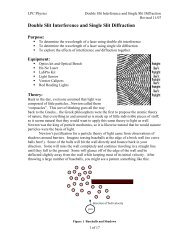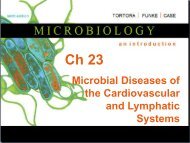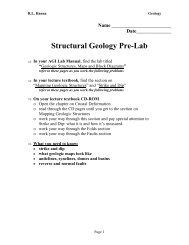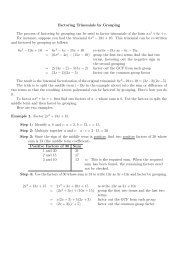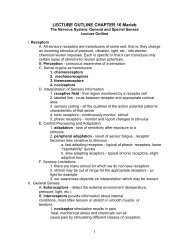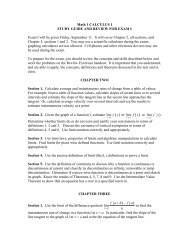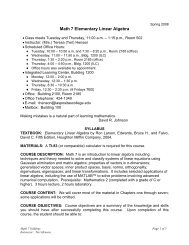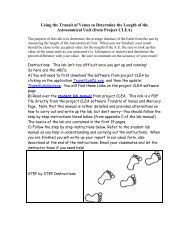Functional Anatomy of Prokaryotic and Eukaryotic Cells
Functional Anatomy of Prokaryotic and Eukaryotic Cells
Functional Anatomy of Prokaryotic and Eukaryotic Cells
You also want an ePaper? Increase the reach of your titles
YUMPU automatically turns print PDFs into web optimized ePapers that Google loves.
Ch 4<br />
<strong>Functional</strong><br />
<strong>Anatomy</strong> <strong>of</strong><br />
<strong>Prokaryotic</strong> <strong>and</strong><br />
<strong>Eukaryotic</strong><br />
<strong>Cells</strong>
Objectives<br />
Compare <strong>and</strong> contrast the overall cell structure <strong>of</strong> prokaryotes <strong>and</strong><br />
eukaryotes.<br />
Identify the three basic shapes <strong>of</strong> bacteria.<br />
Describe structure <strong>and</strong> function <strong>of</strong> the glycocalyx, flagella, axial filaments,<br />
fimbriae, <strong>and</strong> pili.<br />
Compare <strong>and</strong> contrast the cell walls <strong>of</strong> gram-positive bacteria, gram-negative<br />
bacteria, acid-fast bacteria, <strong>and</strong> mycoplasmas.<br />
Differentiate between protoplast, spheroplast, <strong>and</strong> L form.<br />
Describe the structure, chemistry, <strong>and</strong> functions <strong>of</strong> the prokaryotic plasma<br />
membrane.<br />
Identify the functions <strong>of</strong> the nuclear area, ribosomes, <strong>and</strong> inclusions.<br />
Describe the functions <strong>of</strong> endospores, sporulation, <strong>and</strong> endospore<br />
germination.<br />
What you should remember from Bio 31:<br />
Define organelle. Describe the functions <strong>of</strong> the nucleus, endoplasmic<br />
reticulum, ribosomes, Golgi complex, lysosomes, vacuoles, mitochondria,<br />
chloroplasts, peroxisomes. Explain endosymbiotic theory <strong>of</strong> eukaryotic<br />
evolution.
Comparing <strong>Prokaryotic</strong> <strong>and</strong><br />
<strong>Eukaryotic</strong> <strong>Cells</strong><br />
Common features:<br />
‣DNA <strong>and</strong> chromosomes<br />
‣Cell membrane<br />
‣Cytosol <strong>and</strong> Ribosomes<br />
Distinctive features: ?
Prokaryotes<br />
• One circular chromosome,<br />
not membrane bound<br />
• No histones<br />
• No organelles<br />
• Peptidoglycan cell walls<br />
• Binary fission
Size, Shape, <strong>and</strong> Arrangement<br />
Average size: 0.2 -1.0 µm 2 - 8 µm<br />
Three basic shapes<br />
1. Bacillus, -i<br />
2. Coccus, -i<br />
3. Spirals (Vibrio,<br />
Spirillum, Spirochete)<br />
Most monomorphic, some pleomorphic<br />
Variations in cell arrangements (esp. for<br />
cocci)<br />
Review Figs. 4.1, 4.2, <strong>and</strong> 4.4
Spiral Bacteria<br />
Figure 4.4
Pleomorphic<br />
Corynebacteria<br />
Monomorphic<br />
E. coli
Cell Arrangement
External Structures<br />
located outside <strong>of</strong> cell wall<br />
• Glycocalyx<br />
• Flagellum /-a<br />
• Axial filaments<br />
• Fimbria /-ae<br />
• Pilus /-i
Glycocalyx<br />
• Many bacteria secrete external surface layer<br />
composed <strong>of</strong> sticky polysaccharides,<br />
polypeptide, or both<br />
• Capsule: organized <strong>and</strong> firmly attached to cell<br />
wall<br />
• Slime layer: unorganized <strong>and</strong> loosely attached<br />
• Allows cells to attach<br />
key to bi<strong>of</strong>ilms<br />
• Prevents phagocytosis<br />
virulence factor<br />
• E.g.: B. anthracis, S. pneumoniae,<br />
S. mutans
Flagellum – Flagella<br />
• Anchored to wall <strong>and</strong> membrane<br />
• Number <strong>and</strong> placement determines if atrichous,<br />
monotrichous, lophotrichous,<br />
amphitrichous, or peritrichous<br />
Fig 4.7
Flagellar Arrangement<br />
_______<br />
___________
Motility<br />
• Due to rotation <strong>of</strong> flagella<br />
• Mechanism <strong>of</strong> rotation: “Run <strong>and</strong> tumble”<br />
• Move toward or away from stimuli (taxis)<br />
• Chemotaxis (phototaxis <strong>and</strong><br />
magnetotaxis)<br />
• Flagella proteins are H antigens<br />
(e.g., E. coli O157:H7)
“Run <strong>and</strong> Tumble”<br />
Fig 4.9
Axial Filaments<br />
• End<strong>of</strong>lagella<br />
• In spirochetes<br />
• Anchored at one end<br />
<strong>of</strong> a cell<br />
• Rotation causes cell<br />
to move<br />
Fimbriae <strong>and</strong> Pili<br />
• Fimbriae allow<br />
attachment<br />
• Pili are used to<br />
transfer DNA from<br />
one cell to another<br />
Fig 4.10
Cell Wall<br />
• Rigid for shape & protection<br />
prevents osmotic lysis<br />
• Consists <strong>of</strong> Peptidoglycan (murein) <br />
polymer <strong>of</strong> 2 monosaccharide subunits<br />
N-acetylglucosamine (NAG) <strong>and</strong><br />
N-acetylmuramic acid (NAM)<br />
• Linked by polypeptides (forming peptide<br />
cross bridges) with tetrapeptide side chain<br />
attached to NAM<br />
• Fully permeable to ions, aa, <strong>and</strong> sugars<br />
(Gram positive cell wall may regulate movement <strong>of</strong> cations)
Fig 4.13
Gram +<br />
Cell Wall<br />
• Thick layer <strong>of</strong><br />
peptidoglycan<br />
• Negatively charged<br />
teichoic acid on<br />
surface<br />
Gram –<br />
Cell Wall<br />
• Thin peptidoglycan<br />
• Outer membrane<br />
• Periplasmic space
Gram-Positive Cell Walls<br />
• Teichoic acids<br />
Lipoteichoic acid links to plasma membrane<br />
Wall teichoic acid links to peptidoglycan<br />
• May regulate movement <strong>of</strong> cations<br />
• Polysaccharides provide antigenic variation<br />
Fig.4.13b
Gram-negative Cell Wall<br />
Lipid A <strong>of</strong> LPS acts as endotoxin; O polysaccharides<br />
are antigens for typing, e.g., E. coli O157:H7<br />
Gram neg. bacteria are less sensitive to medications<br />
because outer membrane acts as additional barrier.<br />
LPS layer = outer layer <strong>of</strong> outer membrane<br />
(protein rich gel-like fluid)<br />
Fig 4.13
Gram Stain Mechanism<br />
• Crystal violet-iodine crystals form in cell.<br />
• Gram-positive<br />
Alcohol dehydrates peptidoglycan<br />
CV-I crystals do not leave<br />
• Gram-negative<br />
Alcohol dissolves outer membrane <strong>and</strong> leaves holes<br />
in peptidoglycan.<br />
CV-I washes out<br />
For further details <strong>and</strong><br />
practical application see lab
Bacteria with No Cell Wall:<br />
Mycoplasmas<br />
• Instead, have cell<br />
membrane which<br />
incorporates cholesterol<br />
compounds (sterols),<br />
similar to eukaryotic<br />
cells<br />
• Cannot be detected by<br />
typical light microscopy<br />
This EM shows some typically<br />
pleomorphic mycoplasmas, in this<br />
case M. hyorhinis
Acid-fast Cell<br />
Walls<br />
• Genus Mycobacterium <strong>and</strong> Nocardia<br />
• mycolic acid (waxy lipid) covers thin<br />
peptidoglycan layer<br />
• Do not stain well with Gram stain use<br />
acid-fast stain
Damage to Cell Wall<br />
• Lysozyme<br />
digests<br />
disaccharide in<br />
peptidoglycan.<br />
• Penicillin inhibits<br />
peptide bridges in<br />
peptidoglycan.
Internal Structures: Cell Membrane<br />
Analogous to eukaryotic cell membrane:<br />
• Phospholipid bilayer with proteins (Fluid<br />
mosaic model)<br />
• Permeability barrier (selectively permeable)<br />
• Diffusion, osmosis <strong>and</strong> transport systems<br />
Different from eukaryotic cell membrane:<br />
• Role in Energy transformation (electron<br />
transport chain for ATP production)<br />
Damage to the membrane by alcohols, quaternary<br />
ammonium (detergents), <strong>and</strong> polymyxin antibiotics<br />
causes leakage <strong>of</strong> cell contents.
Fig 4.14
Movement <strong>of</strong> Materials across<br />
Membranes<br />
See Bio 31!<br />
Review on your own if necessary (pages 92 – 94)
Cytoplasm <strong>and</strong> Internal Structures<br />
Location <strong>of</strong> most biochemical activities<br />
• Nucleoid: nuclear region containing DNA<br />
(up to 3500 genes). Difference between human<br />
<strong>and</strong> bacterial chromosome?<br />
• Plasmids: small, nonessential, circular<br />
DNA (5-100 genes); replicate independently<br />
• Ribosomes (70S vs. 80S)<br />
• Inclusion bodies: granules containing nutrients,<br />
monomers, Fe compounds (magnetosomes)
Compare to Fig. 4.6
Endospores<br />
Dormant, tough, non-reproductive structure; <br />
germination vegetative cells<br />
Spore forming genera: __________<br />
Resistance to UV <strong>and</strong> radiation, desiccation,<br />
lysozyme, temperature, starvation, <strong>and</strong> chemical<br />
disinfectants<br />
Relationship to disease<br />
Sporulation: Endospore formation<br />
Germination: Return to vegetative state
Sporulation<br />
Fig. 4.21
Green endospores within pink bacilli. Many spores<br />
have already been released from the vegetative cells
The <strong>Eukaryotic</strong> Cell<br />
See Bio 31!<br />
Review on your own if necessary (pages 98 – 106)



